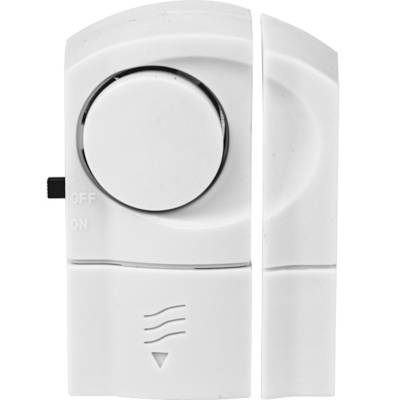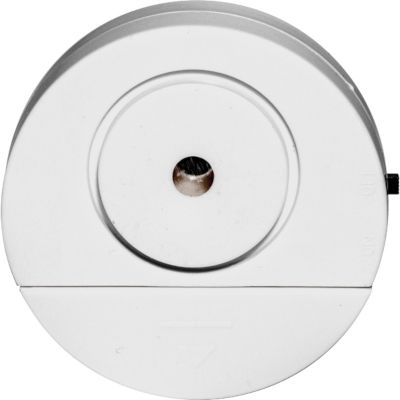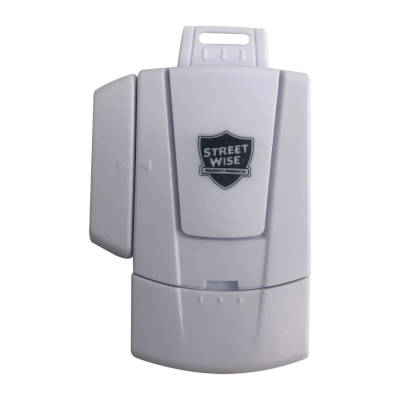Types of Window Alarm Sensors

In an era where technology continually redefines our experiences, home security has embraced innovation to offer unparalleled protection. Window alarm sensors, the sentinel of modern homes, are standing on the front line in shielding our families and prized possessions from unwelcome surprises. In this blog post, we will delve into these innovative devices, understanding their functionality while exploring why they are pivotal in the latest home security technology. Buckle up; it's high time that peace of mind had a technological upgrade!
Window alarm sensors are devices that attach to windows and doors to detect if they have been opened or tampered with. They typically consist of two components – a magnetic contact sensor that is attached to the window frame and a magnet that is attached to the window itself. When the window is opened, the magnet loses contact with the sensor, triggering an alarm. Some window alarm sensors also include additional features such as motion detection or integration with smart home systems for added security and convenience.
Anatomy of a Window Alarm Sensor
Window alarm sensors are an essential component of a comprehensive home security system, acting as the first line of defense against potential intruders. Understanding the anatomy of these sensors is crucial in selecting the right one for your home protection needs.
At its core, a window alarm sensor consists of two main parts: the sensor itself and a magnet. The sensor is typically attached to the window frame or sash, while the magnet is affixed to the corresponding part of the window. When the window is closed, the magnet aligns with the sensor, completing a circuit.
What happens when someone tries to open or break into the window? This disrupts the alignment between the sensor and magnet, causing an interruption in the circuit. This interruption triggers an immediate response, usually in the form of a loud alarm or alert signal.
Depending on the specific model and features, window alarm sensors may also include additional components. These can include tamper switches that detect if someone attempts to bypass or remove the sensor from its position. Some sensors may even have built-in motion detection capabilities that further enhance their effectiveness.
For instance, let's imagine you're away on vacation, and someone tries to forcefully open your window. The window alarm sensor immediately detects this unauthorized entry attempt. The loud alarm starts blaring, startling the would-be intruder and drawing attention from neighbors or nearby security personnel.
It's worth noting that window alarm sensors come in both wired and wireless varieties. Wired sensors require physical connections to a central control panel or security system. On the other hand, wireless sensors use radio frequency signals to communicate with a central hub or smart home automation system.
Furthermore, advancements in technology have led to more sophisticated window alarm sensors that offer additional features such as remote monitoring via smartphone apps, integration with voice assistants like Alexa or Google Assistant, and connectivity with other smart devices for enhanced automation and convenience.
By understanding the anatomy of a window alarm sensor, you can make an informed choice based on your specific needs. Remember to consider factors such as installation ease, compatibility with existing security systems or smart home devices, and the level of protection required for different windows in your home.
Now that we've explored the anatomy of a window alarm sensor, let's dive into the various types of sensors available and the unique advantages they offer for home protection.
- In a 2020 consumer survey, about 48% of the respondents stated they procured their window alarms through online marketplaces such as Amazon.
- According to Statista, the global market size for smart homes, which includes security systems like door/window alarms, reached approximately 77 billion USD in 2020.
- A report published by Safety.com in 2021 suggested that homes without security systems are up to 300% more likely to be broken into; this underscores the importance of having reliable window alarm sensors installed.
- Window alarm sensors consist of two main parts, the sensor itself and a magnet. They are typically attached to the window frame and sash, respectively, and create a circuit when the window is closed. Disrupting this circuit through an attempt to open or break into the window triggers an alert signal or loud alarm, acting as the first line of defense against potential intruders. Consider factors such as installation ease, compatibility with existing security systems, and the level of protection required for different windows in your home when selecting a sensor. Advancements in technology have led to more sophisticated sensors with additional features like remote monitoring via smartphone apps and connectivity with other smart devices.
Exploring Different Sensor Types
When it comes to window alarm sensors, there are several types available in the market, each serving distinct purposes and offering various features. Let's take a closer look at some of these sensor types:
-
Contact Sensors: Contact sensors are the most common type used for window protection. As described earlier, they consist of a sensor and magnet that detect when a window is opened or closed. They are simple to install and highly effective in providing immediate alerts.
-
Glass Break Sensors: Glass break sensors are designed to detect the sound frequency generated by breaking glass. These sensors provide an additional layer of security by detecting forced entry attempts through shattered windows or glass doors.
-
Vibration Sensors: Vibration sensors are specifically designed to detect any vibrations caused by tampering or attempted forced entry through windows. These sensors are highly sensitive and can trigger an alarm even before the window is fully opened.
Picture this scenario: you're sound asleep at night when someone tries to quietly open a window from outside. The vibration sensor immediately detects the subtle movement, activating the alarm system and alerting you to the potential danger.
- Motion Sensors: While primarily used for detecting movement inside homes, motion sensors can also be strategically positioned near windows to provide an extra layer of security against unauthorized entry attempts through those access points.
Depending on your specific security requirements and budget, you can choose among these different sensor types to create a customized and robust home protection system.
Think of it like assembling a puzzle, where each sensor type fits together to form a comprehensive security solution for your home.
Now that we have explored the anatomy of window alarm sensors and the various types available, let's delve deeper into the utility of these sensors in safeguarding your home.
Utility of Alarm Sensors in Home Protection
When it comes to safeguarding our homes, we need more than just sturdy locks and security cameras. That's where alarm sensors prove their worth in providing an additional layer of protection. These cutting-edge devices are designed to detect unauthorized entry, whether through windows or doors, and alert homeowners of potential threats. The utility of alarm sensors lies in their ability to act as early warning systems, allowing prompt intervention and a higher likelihood of preventing burglaries or break-ins.
Glass Breakage Sensor
Imagine you're away on vacation, enjoying some well-deserved relaxation. Suddenly, you receive a notification on your phone that your alarm sensor has been triggered back home. Instantly, panic sets in. However, thanks to the swift notification, you are able to contact the authorities promptly and potentially prevent any further damage or loss.
Alarm sensors work based on various mechanisms such as magnetic contacts, infrared motion detection, or glass breakage sensors. The installation of these sensors can be tailored to your specific needs and vulnerabilities within your home. For example, window alarms can be positioned strategically near ground-level access points or vulnerable areas with valuable possessions.
What sets alarm sensors apart is their ability to act as not only passive deterrents but also active deterrents against potential intruders. By visibly displaying visible alarm signage or window decals, you send a strong message that your property is protected and under constant surveillance. This psychological effect can deter potential criminals from attempting a break-in altogether.
Picture this scenario: A burglar is casing a neighborhood looking for an easy target. As they approach a house with visible alarm sensors in place, they quickly realize that the risk outweighs the potential gain. The mere presence of these sensors adds an extra level of resistance that can push them to move on to an easier target.
Additionally, many modern alarm sensors come equipped with advanced features such as smartphone integration and remote monitoring capabilities. This means you can have peace of mind even when you're far away from home. With the ability to receive instant alerts and monitor your property in real-time, you remain connected to the safety of your home at all times.
Now, let's explore the specific deterrent mechanics that alarm sensors bring to the table against break-ins.
Deterrent Mechanics Against Break-Ins
Alarm sensors act as a key component of an effective security system by providing both proactive and reactive measures against break-ins. Proactively, they serve as a visible deterrent by discouraging potential intruders from targeting your home. The presence of alarm sensors signals that your property is under surveillance, making it less appealing and more risky for criminals.
Furthermore, alarm sensors can trigger loud audible alarms when triggered by unauthorized entry. This immediate response not only startles the intruder but also draws attention from neighbors or passersby. The piercing sound serves as an effective deterrent, causing the perpetrator to panic and abandon their plan, limiting the extent of any potential loss or damage.
Moreover, some advanced alarm sensors offer features like duress codes or silent panic buttons. These discreet functions allow you to silently alert authorities without alerting the intruder. In situations where confrontation may escalate danger, these covert measures ensure your personal safety while law enforcement is alerted discretely.
It's worth noting that the effectiveness of alarm sensors lies not only in their functionality but also in proper installation and calibration. Understanding the layout of your home, vulnerable areas, and optimal sensor placement can significantly enhance their protective capabilities.
Sensor Setup and Calibration
When it comes to protecting your home with window alarm sensors, proper setup and calibration are essential for optimal performance. Before installing the sensors, carefully read the manufacturer's instructions to ensure you understand the process thoroughly. Begin by identifying the ideal placement for each sensor, taking into consideration the layout of your windows and any potential areas of vulnerability.
Once you have determined the best locations for your sensors, it's time to begin the installation process. Start by cleaning the surface where you will be attaching the sensor using a mild detergent or alcohol-based cleaner. This step is crucial as it ensures a secure attachment and enhances the sensor's ability to detect any unwanted intrusions.
Next, use the provided double-sided tape or mounting hardware to securely attach the sensor to your window frame. Positioning is crucial here - make sure that the magnetic portion of the sensor aligns perfectly with the corresponding part on the window frame. This alignment is necessary for accurate detection when the window is opened or tampered with.
After securing the sensors in place, it's time to calibrate them. Calibrating your window alarm sensors involves setting up their sensitivity to detect opening and closing movements accurately. Follow the manufacturer's instructions to properly calibrate each sensor based on its specifications. This step ensures that false alarms are minimized while maintaining a high level of security.
Keep in mind that different types of windows may require specific adjustments during calibration. For example, if you have double-pane or thicker windows, you might need to increase the sensitivity slightly to account for their weight and resistance during opening or closing.
Once you have completed setup and calibration, test each sensor individually to ensure they are functioning correctly. Open and close each protected window while monitoring the response of your alarm system. This step allows you to confirm that all sensors are detecting changes in status accurately and triggering alarms as intended.
Remember that regular maintenance is vital for preserving the effectiveness of your window alarm sensors. Check the sensors periodically for any signs of wear or damage, and replace batteries if needed. Additionally, ensure that the sensors remain clean from dirt and debris so that they can function optimally.
Now that you understand the importance of sensor setup and calibration let's explore some installation tips to further enhance your home security.
Installation Tips for Enhanced Security
When it comes to installing window alarm sensors, a few strategic measures can significantly boost the overall security of your home. Consider these tips to maximize your protection against potential intruders.
-
Strategic placement: Install window alarm sensors on all accessible windows throughout your home. This includes ground-level windows, basement windows, and those on upper floors that may be reachable by external structures like balconies or trees.
-
Layered approach: Combine window alarm sensors with other security features such as door alarms, security cameras, or motion sensors. This layered approach ensures comprehensive coverage and deters potential burglars from attempting entry.
-
Visible deterrents: Make sure the presence of alarm sensors is visible from the outside to act as a deterrent. Clear signage indicating a monitored security system is in place can discourage criminals from targeting your home.
-
Consider professional installation: If you're unsure about the installation process or want expert guidance, consider hiring a professional for proper setup and integration of your window alarm sensors into a comprehensive home security system.
-
Regular testing: Test your window alarm sensors periodically to ensure they are functioning correctly. This proactive approach allows you to identify any issues promptly and address them before they compromise your home's security.
For instance, John, a homeowner, decided to install window alarm sensors throughout his house after experiencing a break-in scare in his neighborhood. He strategically placed the sensors on all accessible windows and combined them with motion-activated security cameras for additional monitoring. The visible presence of these deterrents provided John with peace of mind and significantly reduced the risk of a potential break-in.
Some may argue that window alarm sensors are unnecessary in safe neighborhoods or that relying solely on locks and traditional security measures is sufficient. However, it's important to remember that burglaries can happen anywhere, and proactive measures like window alarm sensors offer an added layer of defense, deterring potential intruders before they even attempt entry.
Now that we have explored the installation tips for enhanced security, let's move on to the next section, which provides an overview of the market for window alarm sensors.
Market Overview of Window Alarm Sensors
In today's fast-paced world, where security and peace of mind are paramount concerns for homeowners, window alarm sensors have emerged as a popular choice. These innovative devices offer an added layer of protection by detecting unauthorized entry through windows and alerting homeowners to potential intrusions. With the rapid advancements in technology and the increasing demand for enhanced home security systems, the market for window alarm sensors has witnessed substantial growth.
Window Alarm Sensor
The market is flooded with a wide range of window alarm sensors, each boasting different features and capabilities to cater to varying needs. From simple magnetic contact sensors that trigger an alarm when a window is opened or tampered with, to more advanced options equipped with motion detection and smartphone connectivity, there is a multitude of choices available to consumers. Such versatility ensures that homeowners can find a solution that aligns perfectly with their requirements and preferences.
Furthermore, manufacturers have taken great strides in improving the functionality and reliability of these sensors. For instance, some high-end models employ cutting-edge wireless technologies like Wi-Fi or Zigbee that allow seamless integration with existing smart home ecosystems. This enables homeowners to monitor their windows remotely, receive real-time notifications on their smartphones, and even integrate the sensors with other security devices such as cameras and door locks. The ease of use and convenience provided by these modern window alarm sensors have contributed significantly to their growing popularity.
Additionally, factors such as affordability and accessibility have played a crucial role in driving the market for window alarm sensors. As technology has advanced, the cost of manufacturing these devices has decreased, making them more affordable and accessible to a broader demographic. Homeowners who previously couldn't afford sophisticated security systems can now reap the benefits offered by these cost-effective alternatives.
The increasing awareness about home security and the rising instances of burglary attempts have also fueled the demand for window alarm sensors. Homeowners are seeking reliable solutions to protect their property and loved ones, and the effectiveness of window alarm sensors in detecting and deterring intruders is widely recognized. In turn, this has spurred manufacturers to invest in research and development, leading to advancements in sensor technology and more competitive pricing.
Think of the market for window alarm sensors as a vibrant ecosystem, where competition drives innovation, affordability expands accessibility, and growing security concerns create opportunities for homeowners to safeguard their homes effectively.
It's important to note that while the market for window alarm sensors continues to expand, it's always advisable to conduct thorough research before making a purchase. Consider factors such as reliability, compatibility with existing home security systems, customer reviews, and the reputation of the manufacturer. This will help ensure you select a quality product that best meets your specific requirements.
In conclusion, the market for window alarm sensors is thriving due to the increasing demand for enhanced home security solutions. With a wide array of options available and constant innovations within the industry, homeowners can now find reliable and affordable window alarm sensors that provide them with peace of mind and protection against potential intrusions.
Check our site and find your home security window alarms.
Add your comment now!
Post Comment





